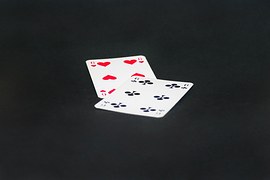 1. In the early stages of the tournament, it is best to just call with small and medium pairs.
1. In the early stages of the tournament, it is best to just call with small and medium pairs.
It is very difficult to win a no-limit hold'em tournament without hitting a set at least once with small or medium pairs. The reason is simple: you can win very large pots when you hit a set with a pair because it is almost impossible for your opponents to put you on that hand. In fact, you even want your opponent to have a hand like pocket kings or pocket aces when you call with a hand like pocket fives.
The most important rule with these pairs is: “No set, no bet.” If you don't hit your set on the flop, you simply fold. You should hit a set or better about one in eight times.
Your goal with small and medium pairs is to win the largest pots possible with the smallest investments. You shouldn't care how many players see the flop, but you should want to see the flop as cheaply as possible. So the question arises: How much should you be willing to pay to see the flop?
As a rule, we can think that we should not risk more than 10% of our chips to see the flop unless the opponent has a very large stack, which would allow us to win a monster-sized pot. It is worth knowing that the odds of hitting a set with a pair are about 7.5 to 1.
Example:
You have a pair of black fours in the cut-off (one position before the dealer). It's the early stage of the tournament, the blinds are 25-25, and you have 2000 chips. A player from early position, with 2500 chips, raises to 100. It would cost you 100 chips to call and see the flop, which is 5% of your chips. Call and see the flop.
Example:
You have a pair of pocket eights in the cut-off, it's the middle stage of the tournament, and the blinds are 200-400. You have 15000 chips. A player from early position, with 25500 chips, raises to 1600. It would cost you a little more than 10% of your chips to call, but the opponent has a large stack for this stage of the tournament, so take the risk and call.
Remember: “No set, no bet.”
2. In the middle or late stages of the tournament, raise with small and medium pairs.
In the middle and late stages of the tournament, the blinds start to have a more significant impact on your chip stack. Moreover, the longer the tournament goes on, the more people start to play tighter and more cautiously.
Your task with these starting hands is either to win the blinds by making everyone fold or to see the flop with minimal risk but with the potential for a big win.
Some players like to just call with small pairs throughout the tournament, hoping to see the flop cheaply. However, this is a very weak line of play because in the later stages of the tournament, it is very beneficial to “steal” the blinds. Also, the chances of improving your hand are very slim. For example, if you limp with a pair of sixes, you know you will have to play against at least one opponent. Since the chances that at least one card on the flop will be higher than your pair are very high, you are left with practically only one chance to win: hitting your set.
Example:
You have a pair of pocket sixes. It's the middle stage of the tournament. The blinds are 400-800, and you have 17000 chips. You raise from early position to 2500. The next player, with 30000 chips, re-raises to 10000. Everyone else folds. What should you do? The pot is 13700, and it would cost you another 7500 to call. It's definitely not worth it, just fold.
Example:
You get a pair of sixes in middle position. It's the middle stage of the tournament. The blinds are 400-800, and you are the chip leader with 40000. In middle position, you raise to 2500. The next player, with 30000 chips, re-raises to 10000. Everyone else folds, what should you do?
The pot size is 13700, and it would cost you another 7500 chips to see the flop, which is more than 10% of your chips. Even if you have the chance to win a huge pot, why take such a big risk at this stage of the tournament? Fold your hand.
 3. In the middle and late stages of the tournament, re-raise with small and medium pocket pairs
3. In the middle and late stages of the tournament, re-raise with small and medium pocket pairs
Re-raising with small and medium pairs is very risky but a very strong move. Your goal when re-raising an opponent is to put enough pressure on them that they fold their hand. This tactical maneuver works great if you haven't been involved in many hands and your chip stack needs a boost.
Example:
You get a pair of pocket eights in the cut-off position. The blinds are 200-400, and you have 6000. You haven't played a hand for a long time, so it's likely that other players at the table see you as a tight player who only plays strong hands. A player in middle position with 9000 chips raises to 1600. Everyone folds to you, what should you do? The worst option would be to call. Don't risk 20% of your chips hoping to hit a set. You must either re-raise or fold. You should decide based on how strong you think their hand is and how the opponent perceives you at the table, your so-called “table image.” Since re-raising would leave you with not many chips, it's best to just say “all in” and risk all your chips.
Tip: How much to raise with pocket pairs from deuces to jacks?
Don't be predictable with your raises. Also, don't make weak-looking “defensive” raises, where you raise slightly more than usual before the flop, signaling to your opponents that you have a very vulnerable starting hand, such as pocket jacks. It will also be harder to make decisions after the flop since you have invested more chips.
Instead, think about how much you are risking and how much you can win. If you get such a vulnerable starting hand, vary your raises based on your position. Raise less when you are in early position, for example, 2.5x the big blind, and raise a bit more in late position.
Of course, you can simplify your raises by always choosing to raise the same amount. Your opponents won't know if you have pocket aces or a pair of deuces if you always raise the same amount.





